Species - Shrimp / Prawns - the 'ICE' system (Indoor Controlled Environment)
Introduction
Over the past several years, techniques have been developed to rear shrimp in 'super intensive' or 'Bio-floc' systems notably in Central / South America, Asia and USA. Rather than rely on the development of phytoplankton to manage water quality, these systems are based on heterotrophic recycling on nutrients into bacterial flocks and biofilm, which both maintain water quality and provide as a secondary food source for the filter feeding shrimp.At Llyn Aqua we have spent 5 years developing our super intensive systems for rearing shrimp. Once more we have forged our own path, not concentrating on just one particular system to super intensify production, but combining our RAS fish production experience and technology with heterotrophic biofloc management to arrive at indoor systems capable of comfortably producing over 20 Kg / m2 tank area per year, and 25 to 30 Kg / m2 for those with good attention to detail and an experienced workforce. At the lower end this equates to 200 tonnes per Ha / yr compared to around 30 tonnes per Ha / yr in the most intensive outdoor pond farms.
We believe that our technology is not only suitable for full scale production of L vannamei, but will also suit other detritus feeders such as P. indicus. It is also applicable to early stages of Black tiger (and similar species) production in nursery tanks. Production in sub tropical areas can be kick started in spring thereby reducing time in lower density grow out ponds by several weeks depending on size they are grown to, and increasing production per unit area.
While our production levels may seem high in relation to conventional shrimp farming, they are very low compared to fish rearing, where Llyn Aqua systems work at 50 - 100 Kg / m3 (for round fish) and up to 300 Kg / m3 for flatfish, so we are well able to maintain all water quality parameters at optimum levels.
What we have done to great effect is take our water quality management skills developed while fish rearing and applied them to shrimp and retained the beneficial aspects of a bio-floc system, ensuring that the four fundamental requirements for healthy growth are maintained.
- good nutrition
- adequate oxygen
- optimum temperature
- good water quality
Which are all closely inter-linked under intensive conditions.
In any closed body of water, or a situation where the quantity of water is limited, the food eaten affects both oxygen consumption and water quality. Low oxygen levels in the water will limit the amount of food eaten and cause stress, disease or direct mortality, as does poor water quality. Temperature affects appetite, digestion and absorption of food as well as the oxygen carrying capacity of the water and toxicity of metabolites. Any successful system must provide a balance between these requirements and also observe some other species-specific parameters such as stocking density. By achieving this, we also eliminate the need for antibiotics or indeed the use of any chemical treatments whatsoever, more organic than 'organic'.
By developing a system applicable to these shores we are now able to produce in the UK (or Northern Europe) very fresh / live product for same or next day delivery (without antioxidant dipping) to the premium market.
By producing shrimp in Indoor Controlled Environment systems (ICE systems) we achieve the following:
- The control of culture conditions to ensure optimum growth and food conversion efficiency. With insulated tanks and building, the water temperature will be maintained year round at 28 Deg. C. With low light levels the growth of phytoplankton is restricted, removing the complexity of managing 'bloom and crash' cycles experienced in open ponds.
Also the shrimp feed better in low light levels. Water movement and gas exchange is performed by aeration and oxygen is delivered by the aeration and by injection of pure oxygen from on site generators ensuring optimum food conversion. The building can be as simple as an insulated 'mushroom tunnel' type structure, which are well tried and tested for maintaining high temperatures with minimal energy inputs, and are the most cost effective way of housing such a plant. Tanks will be of concrete construction of a 'raceway' design, some 2.0 m deep overall and epoxy coated. Size of tanks will depend on overall design capacity, while moveable dividers within the tanks will separate size classes and optimise the growing space.
- Control of disease / Biosecurity. All stock have been brought in from certified disease free hatcheries in the US or Central America. These stocks have already been bred for many generations to be free of / resistant to, major shrimp diseases. Llyn Aqua now holds their own selected breeding stocks selected for high performance in super intensive systems. As this will be the introduction of a tropical species into the UK there will be no chance of either any escapees surviving in the wild and no disease transfer from or to any endemic species. Also, in the tropics, the major sources of contamination with disease vectors are either the water used or wild crustaceans, which enter the ponds, or transfer by birds. In our systems the water exchange is < 1% per day and water drained from tanks during harvesting is reused. Thus it is relatively easy to filter and sterilize all incoming water and prevent wild crustaceans from entering. As the whole system is covered by a 'polytunnel' structure or similar, predation from birds is also easy to eliminate. In the long term, if production increases to over 500 tonnes, we expect a 'mini' hatchery to be cost effective, thereby having even more control over the inputs to the process.
- Market supply. The production cycle can be controlled to supply the markets year round or to concentrate output when seasonal demand commands higher prices. These systems will be in the unique position of being able to supply 'superfresh' high quality product, same/next day of harvest into high end markets, 1000's of miles from the shrimp growing areas of the tropics.
- Of course maximum production relies on a steady monthly output, in which case any seasonal surplus can easily be frozen.
- Reduction of environmental impact on water resources. The ICE system recycles nutrients back into an available food source for the shrimp. The majority of the culture water is retained during harvest. Any outgoing water will flow through a series of outdoor ponds (constructed wetland), again, a technology which Llyn Aquaculture has 9 years experience in the construction and management of.
- Possibility for future expansion / integration with other products. There are several possibilities for integration of other aquaculture products. Other warm water fish such as barramundi, tilapia, even groupers can be grown alongside and the high nutrient pre-heated water used for the shrimp. Even using the water first for temperate species such as sea bass, turbot or sturgeon would provide water pre-heated to 15 - 25 Deg. C. Utilising heat pumps, cold water fish such as Arctic Charr or Halibut could be grown alongside the shrimp and excess heat transferred to the shrimp.
To mop up any remaining nutrients from outgoing water, Llyn Aquaculture has over the past 4 years developed techniques for the culture of Samphire (Salicornia). This salt marsh plant has been received very well in test marketing locally and in France. Grown in constructed beds in clear polytunnels, rather than harvested wild, its major advantage over currently available product is freshness, tenderness (only new shoots are cropped every 3 weeks), and shelf life of up to 2 weeks compared to a few days. It is often eaten fresh as a salty salad, or blanched and served with butter as an accompaniment to sea food dishes.
Environmental concerns
Aquaculture has developed rapidly over the past 20 years, but at a cost to the environment which is now being questioned by both governments and regulatory bodies world wide and increasingly by the consumer, including the transport of products around the world which could equally well be produced in-country. It is increasingly accepted in the tropics that over the medium to long-term shrimp production must move away from shoreline sites and move further inland where the environmental impact can be controlled. Careful use of Closed System Technology in shrimp aquaculture means that it is possible for a production unit to have a near zero effect on the surrounding environment. Large pond farms in the tropics often involve the destruction of large areas of mangrove forest, by partially replacing with our system this can be reduced and some of the lost mangrove areas regenerated. New farms can be built in areas previously considered unsuitable either due to lack of water or low temperatures, and production brought closer to the end user.
Technical Summary
Heating
The use of waste heat if available is of financial advantage, otherwise with the natural heating that occurs in a well designed closed system (losses from all electrical equipment), aided by additional heating in the winter months, temperatures of 28 oC will be maintained by heat pumps which can provide 4 - 5 KW of heat for every KW of power used. Maximum use will also be made of solar heating during the summer and possibly wind turbines. If the unit is large enough then a combined heat and power plant will provide the cheapest source of both electricity and heat, whereby a diesel generator provides electricity and heat from the engine cooling system is used for heating the water. The air will also be heated to 28 oC and ventilation will be via automatically controlled heat exchanger systems based on CO2 levels. Obviously in warmer climates, where daytime temperatures exceed 20 Deg. C, there is no need for additional heating other than solar, to obtain the optimal of ca 28 Deg. C.
Oxygenation, temperature and pH monitoring and control.
Each tank will have its own oxygen and monitoring probe linked back to a central control PC using the Llyn Aqua LASM system, which allows automatic control of in-tank oxygen diffusers. The temperature and pH of each system will be continuously monitored to ensure optimum growing conditions. This system constitutes a major capital cost; but one which is recouped many times over in saved oxygen, better feed conversion, man-hours needed for manual measurements and security of the stock and the recycle process. All parameters are data logged on the PC, which is essential for good system management. (Link to LASM section)
Growth and Survival. The growth model used in this plan is 22 g in 150 days and the predicted survival is 75%, results that have been achieved at Llyn Aqua site many times (Fig 1). In fact we expect the growth rates to improve further over time with advances in feed formulation and selective breeding.
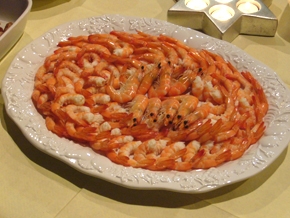
Llyn Aqua ICE shrimp - ready to eat
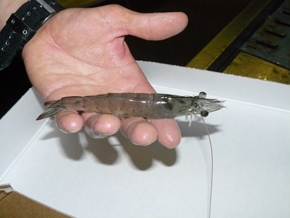
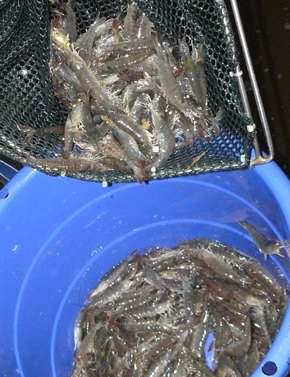
The above shrimp being harvested with no use of antioxidant.
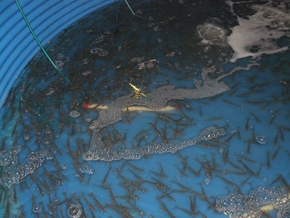
Harvest ready 'purged' shrimp - ie guts emptied and perfectly clean
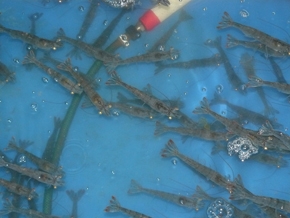
Supberb condition shrimp of 20 - 25g
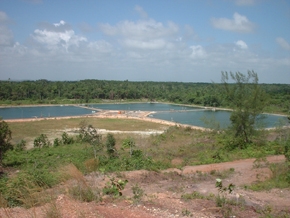
Conventional outdoor tropical shrimp ponds
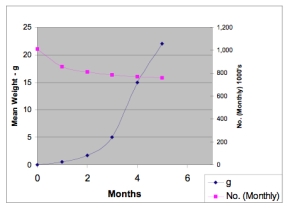
Feed and FCR (Fig 1)
We expect FCR (Food conversion ratio) to be a conservative figure of 1.2 (Kg of dry feed per Kg of fresh weight produced) for the production strategy outlined above. Live brine shrimp, Artemia, are hatched on site and used in the first few days after the shrimp arrive on site, followed by high protein (55-60%) starter feeds readily available in Europe.
As the shrimp grow their protein requirement reduces to around 30% to 35% and cheaper formulations, specifically designed for our ICE system can be used. We can supply tailor made feed throughout the EU at a very competetive price.
We expect FCR (Food conversion ratio) to be a conservative figure of 1.2 (Kg of dry feed per Kg of fresh weight produced) for the production strategy outlined above. Live brine shrimp, Artemia, are hatched on site and used in the first few days after the shrimp arrive on site, followed by high protein (55-60%) starter feeds readily available in Europe.
As the shrimp grow their protein requirement reduces to around 30% to 35% and cheaper formulations, specifically designed for our ICE system can be used. We can supply tailor made feed throughout the EU at a very competetive price.

